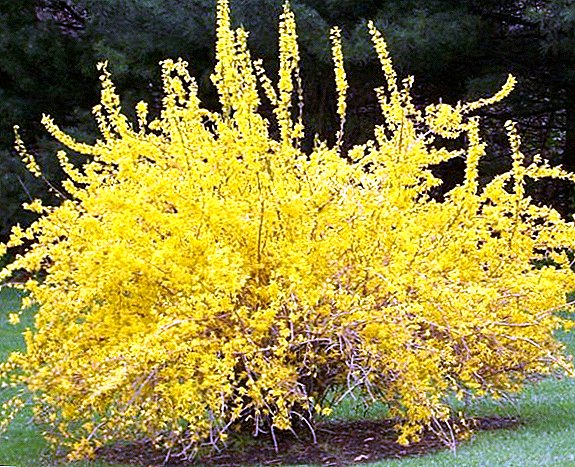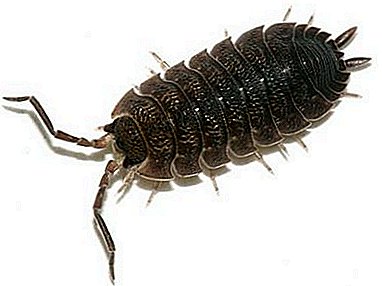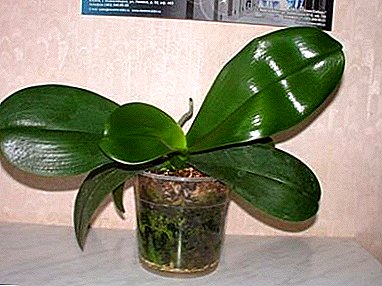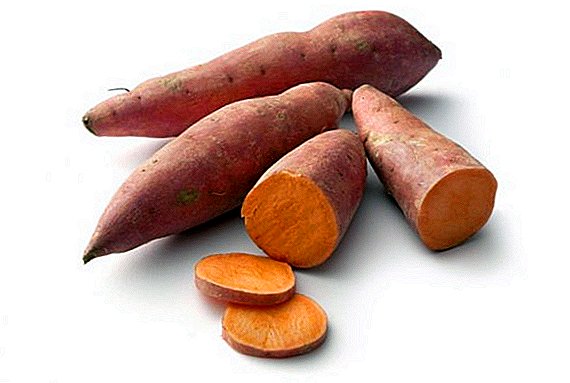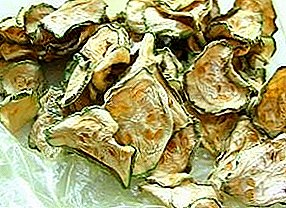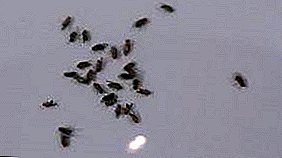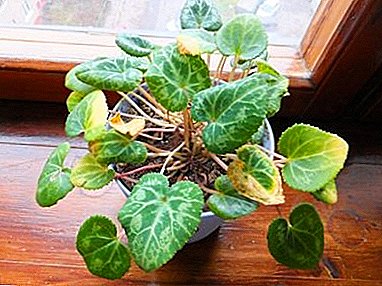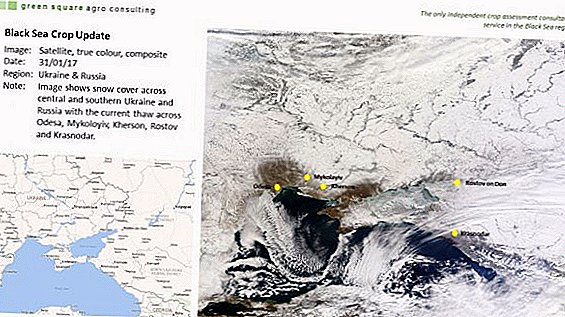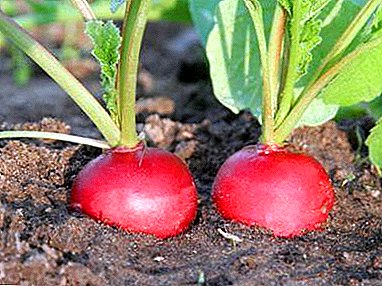
Radish is one of the earliest types of vegetables. It is a variety of the radish of the family Red-colored, the characteristic sharp taste is a sign of the presence of mustard oil in the root crop. Radish helps to compensate for the lack of vitamins and trace elements in the human body, helps to properly digest proteins, strengthens the immune system, normalizes cholesterol levels and is a means for the prevention of diabetes.
This vegetable culture is rich in vitamins of group B, C and E, as well as potassium, phosphorus, sodium, iron, etc. With proper planting and top dressing, the crop can be harvested both in early spring and throughout the summer.
The need for timely feeding
Radish is quite unpretentious plant, can grow on neutral, slightly acidic and alkaline soils, reacting negatively only to acidic soil. However, timely and competent feeding is necessary for the plant - it gives you the opportunity to feed on the necessary trace elements necessary for proper and rapid growth of the root crop.
Important! Do not overdo it with fertilizers, because with a high content in the soil of certain substances, radishes can "go to the tops" or give an arrow ahead of time, which will adversely affect the growth of the root.
Differences when grown in open ground, in greenhouses and at home
Radishes can be grown on open ground, in a greenhouse, at home on a window sill or on a closed balcony. In this case, the proportions of plant nutrition remain the same. However, some rules when growing plants:
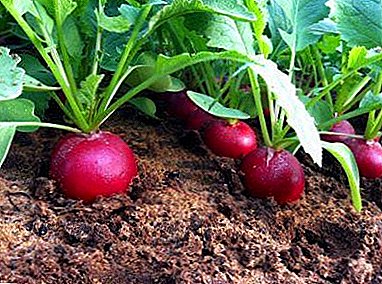 The optimum temperature: + 17 ° + 20 ° C. At a higher temperature, the leaves of the plant will stretch to the detriment of the fruit or the plant will go to seed.
The optimum temperature: + 17 ° + 20 ° C. At a higher temperature, the leaves of the plant will stretch to the detriment of the fruit or the plant will go to seed.- Watering: often in small portions.
- Lighting: 8-10 hours of daylight. In early spring it is better to choose a sunny place for planting, in the middle of summer - partial shade.
- Depth of the involved soil: 15-20 cm.
- Distance between seeds: 4-6 cm.
- Well, if earlier on the soil grew: tomatoes, cucumbers, potatoes, as well as plants of the legume family.
- It is advisable to pre-soak the seeds for 12 hours.
- Radish DOESN'T LOVE:
- Sour soil.
- Heavy soil. It is necessary to loosen the soil, it helps to form a root crop of the correct form and prevents arrows of plants.
- Fresh organic fertilizers, manure, for example. In this case, the radish will be empty.
- If earlier on the same land grew: cabbage, turnip, radish, daikon
Fertilizer time difference
After sprouting
If the soil is properly fertilized before planting, then young radish seedlings do not need any additional feeding, but if the soil could not be fertilized, it is possible to feed the first 2-3 leaves with any potash or phosphorus-potassium fertilizer according to the instructions on the package.
When the plant has grown
When a plant has grown, it can be determined from its condition what kind of fertilizer it needs at the moment. The following signs should be noted.:
- If the leaves have grown too large, and the root crop has stopped in growth, should be applied phosphorus-potassium fertilizer. In addition, radishes can be watered with a special solution consisting of 1 cup of ash, 20 g of potassium sulfate, 40 g of superphosphate per 10 liters. warm water.
- If the leaves of radish are pale, then it lacks nitrogen. Fertilizer GROWTH or 1 tsp. urea, dissolved in 10 l. water will provide growth not only the leaves, but the roots themselves.
- If the plant is affected by a medvedka or cruciferous fleas, it should be 10 liters. water to stir 500 grams of ash and 60 grams of crushed or rubbed soap. The resulting solution to spray the plant. In addition, you can dilute the mustard powder in water and spike the plant with it.
The use of various means depending on the season
Soil preparation
 Preparing the soil for sowing radish is best in autumn or early spring.when the snow melted. How to fertilize the soil in spring when planting seeds for their rapid growth and better yield? To do this, dig a plot of land on which the seeds will be planted and apply the following fertilizers per 1 m² of area:
Preparing the soil for sowing radish is best in autumn or early spring.when the snow melted. How to fertilize the soil in spring when planting seeds for their rapid growth and better yield? To do this, dig a plot of land on which the seeds will be planted and apply the following fertilizers per 1 m² of area:
- 1 tbsp. ash sifted;
- 10 g of urea;
- 40 g of superphosphate.
Another composition of spring radish fertilizers is possible:
- 20 g. Of potassium sulphurous;
- 4 kg. humus;
- 20 g of superphosphate;
- 10 g. Nitre.
How to treat the area before seedling?
Complex seed fertilizers and growth stimulants can be used up to seedlings and at the initial stage of growth., such as:
- agrovit;
- gumi-omi;
- Kalimag;
- Agricola;
- potassium monophosphate;
- potassium sulfate;
- potassium humate;
- potassium phosphorus, etc.
During the growing season
During active growth, you can feed radishes with the following fertilizers.:
- ammonium nitrate;
- superphosphate;
- potassium sulfate.
Application rate - guided by the instructions of the selected funds. You can purchase them at any gardening store or online store.
How to make a healthy mix for the root?
How to fertilize radish for filling to grow faster?
Infusion of compost
 One of the easiest ways to make fertilizer for radish yourself is to make an infusion from compost. To do this, 500 g of mature compost must be diluted in 10 l. water and let stand for three days, after which the infusion should be thoroughly drained and water the plants, not diluted with water. It is not advisable to pour radishes under this solution under the scorching sun.
One of the easiest ways to make fertilizer for radish yourself is to make an infusion from compost. To do this, 500 g of mature compost must be diluted in 10 l. water and let stand for three days, after which the infusion should be thoroughly drained and water the plants, not diluted with water. It is not advisable to pour radishes under this solution under the scorching sun.
On herbs
Same Herbal infusions can be used as fertilizer.. They are quickly absorbed, safe and can be used at any stage of plant growth. It is advisable to use the following herbs in the infusion:
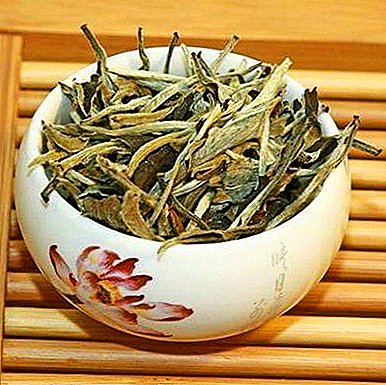 chamomile;
chamomile;- comfrey;
- colza;
- tansy;
- nettle;
- horsetail and others.
In addition to the broth, you can add:
- wood ash;
- onion peel;
- bird droppings;
- garlic arrows.
Wood ash
 Woody ash makes up for potassium deficiencytherefore, it can be used as an independent fertilizer. Ashes are fed radishes not only before planting, but also during the growth of the vegetable, it can be watered with liquid ash fertilizing. To do this, 250 g of ash should be stirred in 10 liters. water and water in the evening with this solution plant under the root. If ash is used as a fertilizer, it is advised to adhere to some rules:
Woody ash makes up for potassium deficiencytherefore, it can be used as an independent fertilizer. Ashes are fed radishes not only before planting, but also during the growth of the vegetable, it can be watered with liquid ash fertilizing. To do this, 250 g of ash should be stirred in 10 liters. water and water in the evening with this solution plant under the root. If ash is used as a fertilizer, it is advised to adhere to some rules:
- Do not deposit ashes in alkaline soil.
- Ash completely neutralizes the effect of nitrogen fertilizers, especially ammonium nitrate and urea, so they should not be applied earlier than a month after using ash.
Nettle
 Nettle fertilizer - treats the plant for red fleas, accelerates the formation of chlorophyll and root crops. To do this, cut a bucket of nettle and fill it with water, leaving it for a week in the sun, not forgetting to stir it regularly. After adding the infusion into the water 1 to 10 and watering the beds in the rows.
Nettle fertilizer - treats the plant for red fleas, accelerates the formation of chlorophyll and root crops. To do this, cut a bucket of nettle and fill it with water, leaving it for a week in the sun, not forgetting to stir it regularly. After adding the infusion into the water 1 to 10 and watering the beds in the rows.
Harvesting should be no earlier than three days after feeding plants. In the opposite case, the nitrates will not have time to split in the root and benefits from the use of such vegetables will be small.
Undoubtedly, in order for the crop of radish to please the gardener with his forms and taste, you should invest a little of his strength in it and devote attention and time to feed it. But in this case, the result will not be long in coming, and nature will certainly reward the gardener with a juicy, useful and ruddy radish crop.


 The optimum temperature: + 17 ° + 20 ° C. At a higher temperature, the leaves of the plant will stretch to the detriment of the fruit or the plant will go to seed.
The optimum temperature: + 17 ° + 20 ° C. At a higher temperature, the leaves of the plant will stretch to the detriment of the fruit or the plant will go to seed. chamomile;
chamomile;